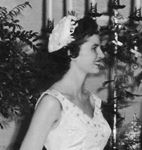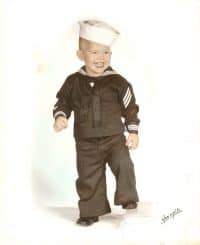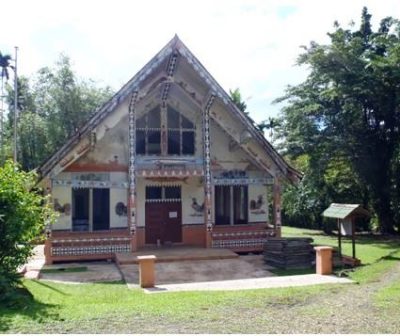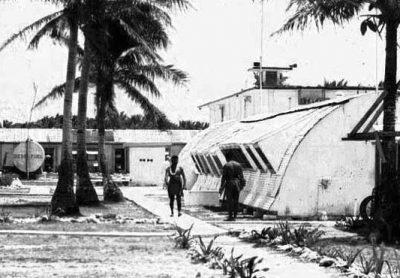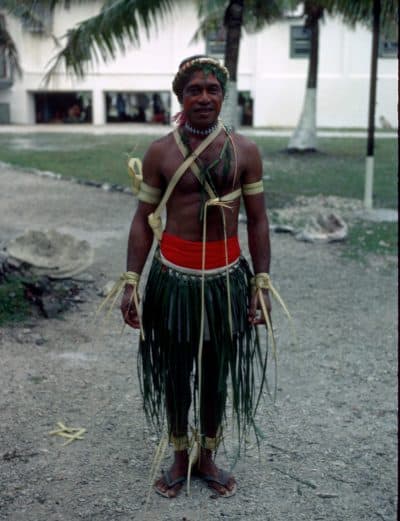John Moseley, Coast Guard Aviator 743
Foreword:
This story, in a sense an adventure, tells of our tour in Guam. It took place in a time and environment that is no more. I look back upon it with fondness and yes gratitude for the opportunity to have experienced it. As a family, we had a choice to either enjoy the tour or hate it. We chose to enjoy it. As for the Air Detachment: it was a close-knit group and morale was amazingly high. The mission was unique and afforded the opportunity to be part of and witness a different world. As for the title – Hafa Adai is Chamorro, the native language of Guam and the Northern Mariannas., It has the same meaning as the Hawaiian Aloha. A Salty Dog is a libation consisting of grapefruit juice and vodka with a ring of salt around the top of the glass. It enjoyed widespread consumption, especially on the golf course. It was here that BJ learned to play golf. She became quite good at it. In fact- she is the only one in the family to get a hole in one.
The Beginning
BJ, me and our two boys left CGAD Biloxi for Maintenance Officer Training at Chanute AFB, located at Rantoul Illinois, during September of 1959. The boys, John and Mike, experienced their first snow that winter. John liked it – Mike the younger was not sure. Treatment by the Air Force was outstanding. However, some were a little confused by the green uniform and a Lieutenant wearing Captain Bars.
Time passed rapidly and I graduated the following June. Orders came through and we were going to CG Air Detachment Guam. I told BJ and she said GUAM!! I assured her that there were many palm trees, sandy beaches, beautiful sunsets and no snakes. This was true at the time as the Brown Tree Snakes came later due to cargo ships from the Philippines.
Then the news came that there was a housing shortage in Guam and a waiting list for Base Housing. With that in mind, I took a little leave plus travel time and we departed Rantoul for San Francisco taking our time and enjoying the trip. San Francisco was the departure point for Guam. I really did not want to leave her with two small boys to take care of but I had no choice. It helped that we knew several couples stationed at CG Air Station San Francisco.
Two and one-half months later housing became available. BJ took care of everything at her end, placed the car was on the dock for shipping and she and the boys flew to Guam. There was a stop in Hawaii and another at Wake Island for a mechanical. In addition to the many hours flown, young Mike added to the stress as he decided that he was not to keen on flying and the best seat on the aircraft was his mother’s lap. This convinced BJ that when it was time to leave Guam it would be on an MSTS ship and when the time came we did.
When BJ and the boys arrived I was one happy camper! She was greeted by all and with a lei placed around her neck, we were soon off to our house As we walked through the front door we were greeted by a Gecko. Now on Guam Geckos are fat and grow to 5 to 6 inches long. However, BJ was working on the second day without sleep and it did not faze her at all.
The base housing at NAS Agama was two-story cinderblock duplexes. The end of the building was solid as were interior load bearing walls but the front and back were all louvers. The houses were up on a bluff and even without air-conditioning, they were quite comfortable.
The Air Detachment:

The Air Detachment was on the west side of the runways. A substantially modified Quonset served as the Administration Building, A second Quonset for supply and shops and a portion of a very large Quonset that allowed the UF-2G, all except the tail section, to be placed inside for maintenance. There were four aviators, 14 enlisted personnel and one UF-2G (HU-16E) The reason for the Air Detachment was to supply the LORAN stations in that part of the Pacific. The LORAN stations were Ulithi, Anguar, and Saipan. Saipan was personnel only when warranted. Ulithi and Anguar were weekly. However, the Trust Territories had been established and they did not yet have their own air transportation between the islands. Thus we flew Trust Territory personnel to Koror, Ponapea, Yap and Chichi Jima for the Navy, when needed, in addition to the LORAN stations. I do not remember any specific authorization to do so but somehow it was not needed. In fact, we did quite a few things that I do not recall getting official authorization for. The WORD was out that if you needed something done and you did not know how you can do it – then call the Coast Guard.
We worked on a schedule for the most part. SAR was mostly Medevacs from the islands. There was one major search and one C-124 intercept while I was there. This made maintenance easier. What made it harder was the fact that the AR&SB, the part supply source, was 8000 nautical miles to the east at Elizabeth City NC. An arrangement for part support was set up with CG Air Station Barbers Point, Hawaii. This was 3900 hundred nautical miles away. The Navy on Guam had a UF-1 and quite often we would borrow from them if they had it and then replace it when the part we ordered came in. Many times we found ourselves “fixing” a part and using it. The guys were absolutely amazing when it came to “fixing “.
Anguar:
Anguar is an island in the Palauan Chain (Western Carolines) with an area of three square miles and a population that varied around 300 at the time. It lays 690 nautical miles southwest of Guam and 545 nautical miles east of the Philippine Islands. The population of Palau, primarily Melanesian, had experienced outside influence by both Japanese and German administrations which introduced coconut planting and phosphate mining to the islands. Anguar, as well as the adjacent island of Peleliu, saw extensive military battles during World War II. When the islands were taken from the Japanese a 7000-foot runway was built on Anguar to accommodate B-24 bombers in the campaign against the Philippine Islands. This runway was maintained and used to supply the LORAN station located a short distance away. We delivered once a week with supplies. Those ordered through channels and those requested and obtained outside the system. The relationship between the locals and the Coast Guard was excellent. Movies were always open. The crew each got a beer ration of a case a month. In reality, this was not nearly enough for 7.00 degrees north of the Equator – Thus Susie came to the rescue. She had a kerosene refrigerator and a place to enjoy a beer island style with Susie attending. As I recall .maybe 2 brands of beer……San Miguel, which was the Budweiser of the Pacific, and the .other a Japanese beer – maybe Sapporo. I had a chance to go fishing there a couple of times. Great!
The station personnel looked forward to our arrival. It meant mail, other “stuff.” and a break in a routine which could lead to boredom and apathy. George
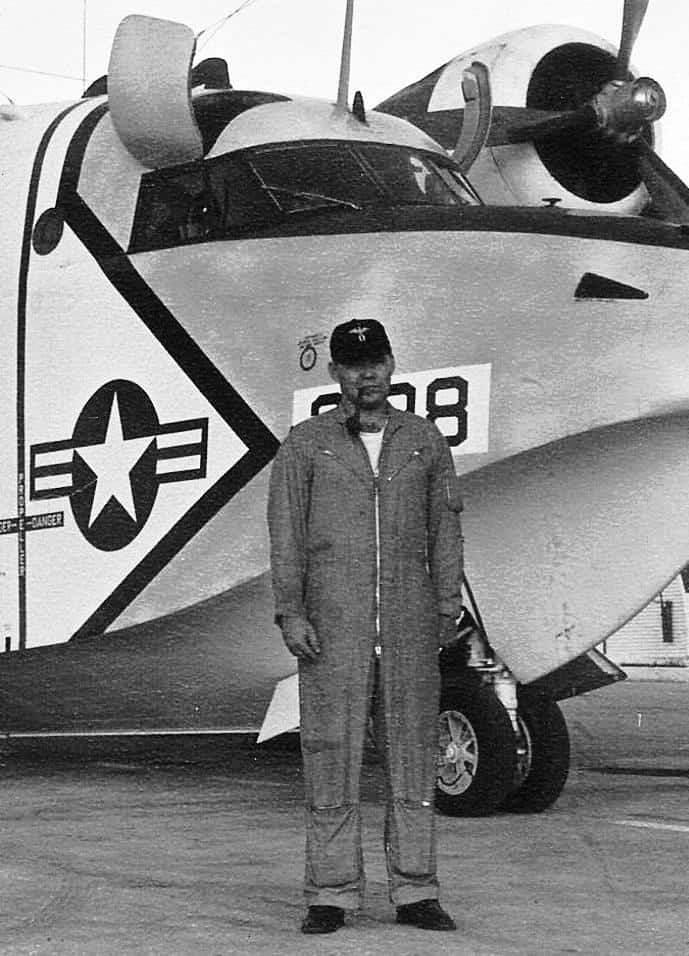
Oberholtzer was the CO and quite good at antics to boost morale. A few examples: They rigged a spyglass up as a transit in the back of the station truck and gave us GCA approaches coming in. They got good at it. They had a Korean War vintage fire truck that had foam capabilities. More than once on roll out we heard “Fire Drill” over the radio and knew what was coming. Immersed in foam!
The UF was not designed to be a cargo plane. When going to Anguar the problem was cargo weight plus fuel weight verses takeoff weight limitations. The crew became quite proficient with the load and balance slip stick – The trip was planned with enough fuel to get there and back. There were times, primarily due to a wide band of thunderstorms in the Intertropical Convergence Zone, when this was not the case. When this occurred we added fuel from 55-gallon drums that had been transported to Anguar by the 180 foot Buoy tender out of Hawaii during its regular scheduled run. Fuel was hand cranked into the float tanks and then transferred to the main tanks. We did not fuel unless necessary. It had to last until the next scheduled Buoy Tender arrival.
Koror:
Most of the time we stayed overnight at Koror. Koror was 35 nautical miles northeast of Anguar. At times there were Trust Territory people aboard as Koror was the Capital of Palau at the time. However, the primary reason was that the LORAN station was not equipped to handle overnight guests on a regular basis. Koror was a water operation but we did not anchor. We taxied up and parked on the ”hikouki” ramp, pronounced by the locals as scogee meaning airplane. Why the combination of Japanese and English I do not know. The Japanese used seaplanes extensively during WWII and many of the islands had airplane ramps. The one in Koror was maintained in excellent condition.
Koror was and is the largest city in Palau. I would guess the population in 1960 as about 4500. Construction was primarily plywood, cinder block, and metal siding. Today it is a modern city with three times that population. .We stayed at the “Royal Palauan Hotel”.
It was in the Palauan Islands that I first saw a Bai. There are different kinds of Bai. The most important, most significant, most elaborate is the bai er a klobak, the seat of the council of chiefs of each village, The bai el beluu is used by women and all community members for many kinds of functions such as feasts, planning, meetings for fishing expeditions, meetings to plan dances, meetings to welcome guests from other villages,
Ulithi:
Ulithi is an atoll in the Caroline Islands of the western Pacific Ocean 367 nautical miles Southwest of Guam. It consists of40 islets surrounding a lagoon about 22 miles long and up to 24 miles wide. There are four inhabited islands on Ulithi Atoll. They are Falalop, Asor, Mogmog, and Fedarai. Other important islands are Losiap, Sorlen, and Potangeras. The original LORAN station was built on Pontangeras Island and in 1953 it was moved to Falalop to be adjacent to a 3300 foot paved landing strip. The runway extended from ocean edge to ocean edge.
The Coast Guard personnel got along very well with the Ulithians. Twice a year, Christmas and the Fourth of July, people from all the inhabited islands were invited to the Loran station on Falalop to celebrate. Activities were athletic games, native dancing, and a feast. Movies were always open and well attended by the people of Falalop. Inhabitants of the other islands would periodically come over for that purpose also.
The people who live in and around Ulithi are classified as Micronesian. Their appearances vary greatly because of all the different people who passed through the area over time. Ulithian is the language but English was spoken, especially amongst the young. Those on Falalop were the most proficient because of the interaction with the people at the LORAN station.
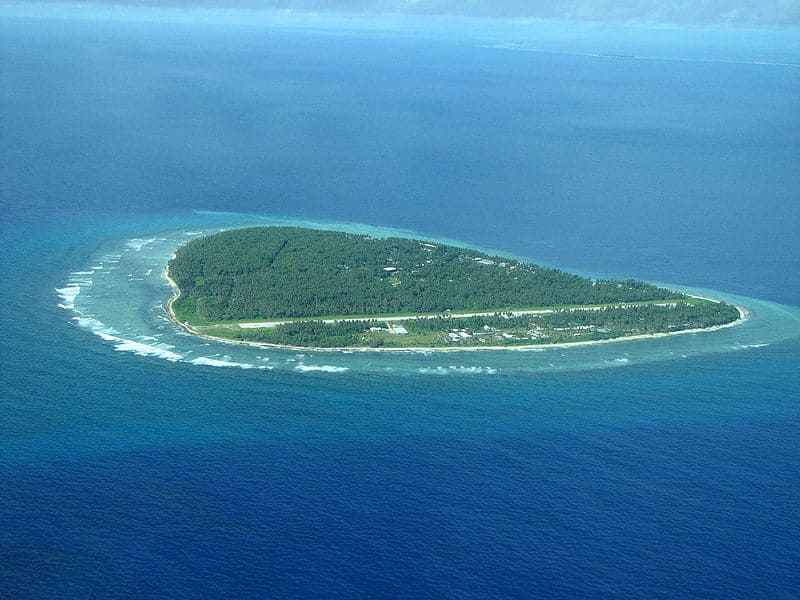
Saipan:
Saipan, located 105 nautical miles north of Guam, is the second-largest island in the Mariana Islands archipelago. Japan was awarded formal control of the island in 1918 by the League of Nations. Saipan was important to Japan both militarily and economically and became the center of subsequent Japanese settlement. After WWII the remaining Japanese were repatriated to Japan. The U.S. Navy administered the Island until 1962, when administration transferred to the Department of the Interior.
Climate and Flora were much the same as Guam. We used Koebler Field which was close to the LORAN station. Flights were turnarounds and of an administrative nature.
Yap:
We went to Yap when requested by the Trust Territory people. Yap was a water operation. It is 466 nautical miles southwest of Guam and 93 nautical miles west-southwest of Ulithi. It is made up of one main island and three smaller ones separated by water and surrounded by a coral reef. They were formed from an uplift of the sea plate as opposed to an atoll. The land is mostly rolling hills, densely vegetated mangrove swamps line much of the shore, although there are beaches on the northern end. A LORAN C station went operational on Yap at the end of 1964, after we had left Guam and Ulithi was closed.
 A main attraction for the outsider is the Rai or stone money. The money is large circular stone disks carved out of limestone. Rai stones were quarried on several of the Micronesian islands, mainly Palau, and transported for use as money on Yap. They have been used in trade by the Yapese as a form of currency. Because these stones are too large to move, buying an item with one simply involves agreeing that the ownership has changed. As long as the transaction is recorded in the oral history, it will now be owned by the person it is passed on to and no physical movement of the stone is required. Modern currency has replaced the stones as the everyday currency. However, the rai stones are still exchanged in traditional ways between the Yapese. Note the stone money in the picture in front of the house.
A main attraction for the outsider is the Rai or stone money. The money is large circular stone disks carved out of limestone. Rai stones were quarried on several of the Micronesian islands, mainly Palau, and transported for use as money on Yap. They have been used in trade by the Yapese as a form of currency. Because these stones are too large to move, buying an item with one simply involves agreeing that the ownership has changed. As long as the transaction is recorded in the oral history, it will now be owned by the person it is passed on to and no physical movement of the stone is required. Modern currency has replaced the stones as the everyday currency. However, the rai stones are still exchanged in traditional ways between the Yapese. Note the stone money in the picture in front of the house.
Ponapea:
Ponapea was a Trust Territory operation. — It is a volcanic island, 890 nautical miles southeast of Guam, with a diameter of 9.5 miles covered by a barrier reef.
One of the biggest mysteries of our time is located in the eastern part of the island of Ponapea. It is Nan Madol — ninety-two man-made islands that were built on a coral reef. They are composed of large hexagonal and octagonal basalt columns weighing from one to ten tons. The slabs were stacked in rows up and down. The tops of many platforms were flat, suitable for the construction of buildings. Seawater is between the platforms resulting in a network of canals. Scientists have identified the beginning of the construction of the city as approximately the second century BC. Little can be verified about the construction. Ponapean tradition claims that the builders migrated to Ponapea, where they used their skills and experience to build the even more impressive Nan Madol complex. The Dynasty is said to have died out.
Guam:
Guam is 32 miles long and 4 to 12 miles in width. The island is divided into a northern plateau with a general elevation of about 500 feet and a higher area of volcanic hills to the south. The plateau is covered with a thick growth of jungle, while the volcanic hills support mainly sword grass. The hills rise to an elevation of more than 1,000 feet. Mount Lamlam, in the southwest, rises to 1330 feet. Guam has a pleasant tropical climate tempered by the northeast trade winds. BJ’s mother, in a letter, asked about the climate. BJ wrote back that is 86 degrees during the day, 76 degrees at night and that it rained a bit every day but the people didn’t bother with umbrellas. That sums it up but it is a little wetter in the Spring as opposed to the rest of the year.
There was a heavy military presence in Guam. Anderson Air Force base was at the north end of the island; the Naval Air Station adjacent to Agana, and a large Navy presence at Apra Harbor. The Coast Guard units consisted of the Marianas Section Command, Cocas LORAN Station, the Coast Guard Radio Station and the Air Detachment. The relationship with the local people was good. The Guamanians had been given US citizenship in 1950.
Morale-wise, Guam was what you wanted to make it. At the Naval Air Station, there was a swimming pool, a bowling alley, golf course, nursery, and exchange. The commissary was at the Naval Station. But for us, it was the Island and the people. There were beautiful beaches on Guam. Some with wide sandy beaches lined with palm trees and others with a rocky shoreline. Picnics swimming and snorkeling was in. All types of fish and coral to be seen. There was the jungle and the waterfalls at Talofolo and lest we forget – the beautiful Flame Trees. The uniform of the day for the two boys was shorts, T-shirt and rubber sandals held on by a thong between the big toe and the one adjacent to it.
It was in Guam that Erena Kadiahsong came to live with us. She was a really wonderful young lady. Action by the Trust Territory had set up an educational system but on many of the islands, there was no high school or higher education. There was an arrangement made that those young students could continue their education in Guam if they had a family that would sponsor them. The young people were not to be used as maids or servants. They came from all over the territories with different languages so communication between them was in English. The system worked well. Our Next door neighbor, who was the head of Base Security, told us that one of the students had lost a sponsor and would we be willing to take her. Erena was from the Palauan Island of Babeldoab. Babeldoab was one of the most underdeveloped populated islands in the Trust Territories, even though it is the second largest island in Micronesia. It seems Erena had put red socks in the washing machine with a white uniform. This was perfectly understandable for a person that had never seen a washing machine before. We said yes.
Erena was a winner, BJ would do a chore first while Erena watched, then they would do it together, then Erena would do it and it would be perfect. I was Dad and BJ was Mom simply because that is what the boys called us and what we called each other when speaking to them. It was a love affair between the boys and Erena – opening coconuts, climbing the mango trees, going to the pool and the beach. Erena was part of the family and treated that way.
One day, from inside the house, I heard a faint “Dad”. I went outside and looked and Erena was at the top of one of the palm trees.. Now that girl was amazing – she could go up a palm tree faster than I can tell the story. At the foot of the tree was the next door neighbors Dachshund barking for all he was worth. I put the dog back on his porch and Erena came down the tree. On Babeldoab the dogs were wild and dangerous. I knew this – when she came back down the tree she looked a little embarrassed – I just gave her a hug.
I am still amazed at how well she transitioned and adapted to something she had never been exposed to before. Erena finished high school and went on to graduate from the College of Guam.
There were R&R trips. BJ and I had the opportunity to visit and vacation in the Philippines, Hong Kong, and Japan. It was a once in a lifetime adventure.
Guam was Good!

